More than seven weeks out from the Iranian-sponsored Hamas terrorist attacks on Israel, new TIPP polling reveals how the American people are responding to the attacks, as well as to the ensuing war in Gaza and spreading protests here at home.
While—as with most polling—gender, ethnicity and political affiliation appear to drive some responses, perhaps the single most striking takeaway from the full poll is the consistent discrepancy in the answers broken down by age group, with younger respondents strongly more likely to take a pro-Palestinian position, while older respondents are considerably more likely to be pro-Israel.
TIPP asked six questions in this poll. Two concerned views on Israel, two on opinions about the Palestinians, and two on the Islamic republic of Iran.
In response to the question, “Should the United States support or oppose an Israeli ground invasion of Gaza in retaliation to the Oct. 7th attacks?” support outweighs opposition across all respondents at a roughly 2-to-1 margin, with the sole exception of the 18-to-24-year-old age group.
In that group, 25% support while 32% oppose the Israeli action. An even larger group, however, is unsure (43%), which is the largest group of “unsures” responding to this question, except for women (44%), reflecting considerable ambiguity on this issue and possibly reflecting female concerns that American troops might be drawn into the fighting.
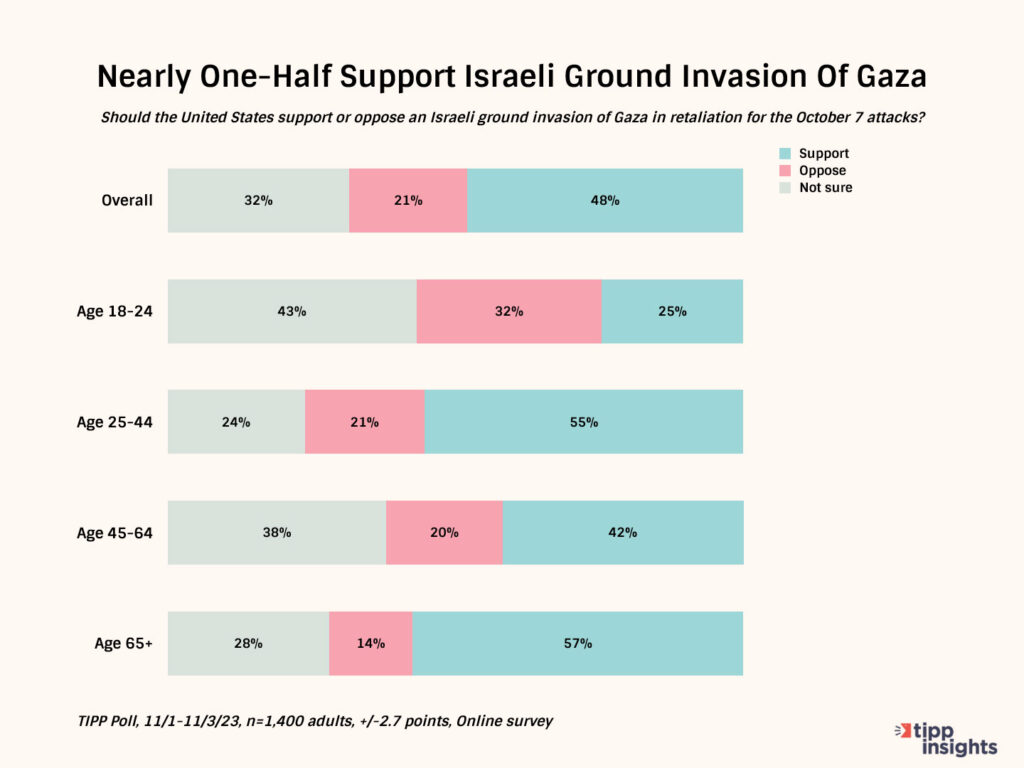
The second question on Israel concerned views on the support America is providing to the wars in both Ukraine and Israel.
In response to the question, “Should the United States prioritize aid to Israel or Ukraine,” the largest numbers of respondents favored aid to Israel (26%) or both countries equally (35%) for a total of 61%. Only 9% favor prioritizing Ukraine, while 12% are unsure.
Across the board, Israel outpolled Ukraine, even in the 18-to-24-year-old demographic. Among that group, however, the numbers were much closer than in the rest of the poll, with 16% preferring Israel and 12% preferring Ukraine.
Still, taken in aggregate, this data suggests that requests for additional aid that disproportionately favors Ukraine, such as President Joe Biden’s recent emergency supplemental that included $60 billion for Ukraine versus $14 billion for Israel, may not enjoy broad support in Congress.
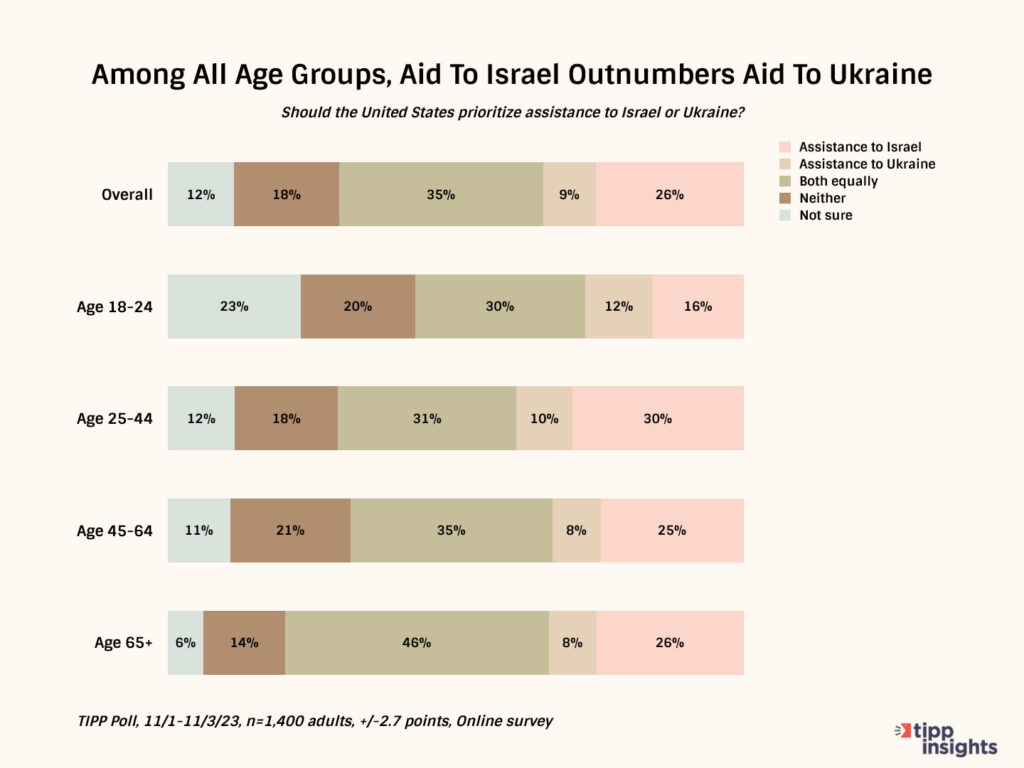
The question “Should the United States provide more assistance to the Palestinians?” provoked some of the most diverse data in the poll, with wide discrepancies across age groups, ethnicities and political affiliations.
Overall, 40% agreed more aid should be provided, with 34% disagreeing and 27% unsure. Agreement was strongest among 18-to-24-year-olds, blacks and Hispanics, and liberals, with 54%, 56% and 61% agreeing, respectively.
Conversely, disagreement was strongest among respondents who are 65+ (46%), white (39%) and/or Republican (48%). So, while the largest group of respondents to this question support additional aid, this is far from a bipartisan, majority position, suggesting additional requests for funding may encounter resistance in Congress.
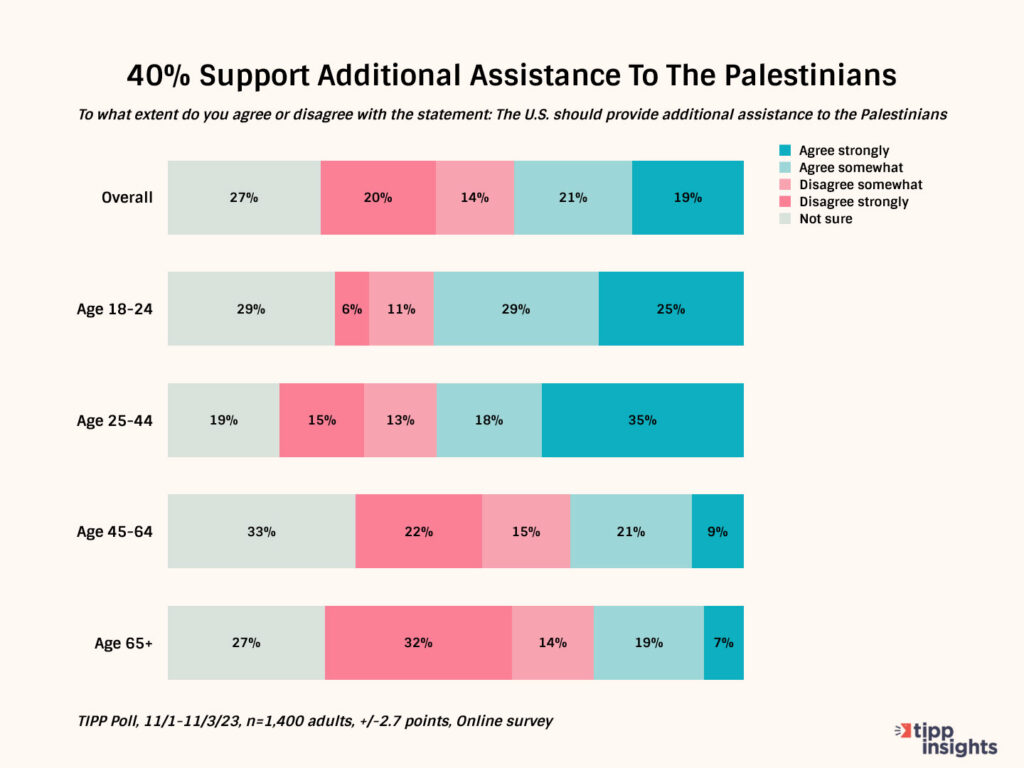
When asked whether respondents approved or disapproved of the pro-Hamas protests breaking out across America, a majority (51%) of respondents disapprove, while 27% approve and 21% were unsure. But broken down for degrees of disapproval or approval, the largest group of respondents (36%) strongly disapproved, while 15% disapproved somewhat, 12% approved somewhat, and 15% approved strongly.
Once again, the 18-to-24 age bracket was the most evenly split with 32% disapproving and 30% approving—but even more respondents (37%) were unsure, suggesting that even with the public support these demonstrations are receiving on college campuses, there may be more ambiguity among students than has been documented.
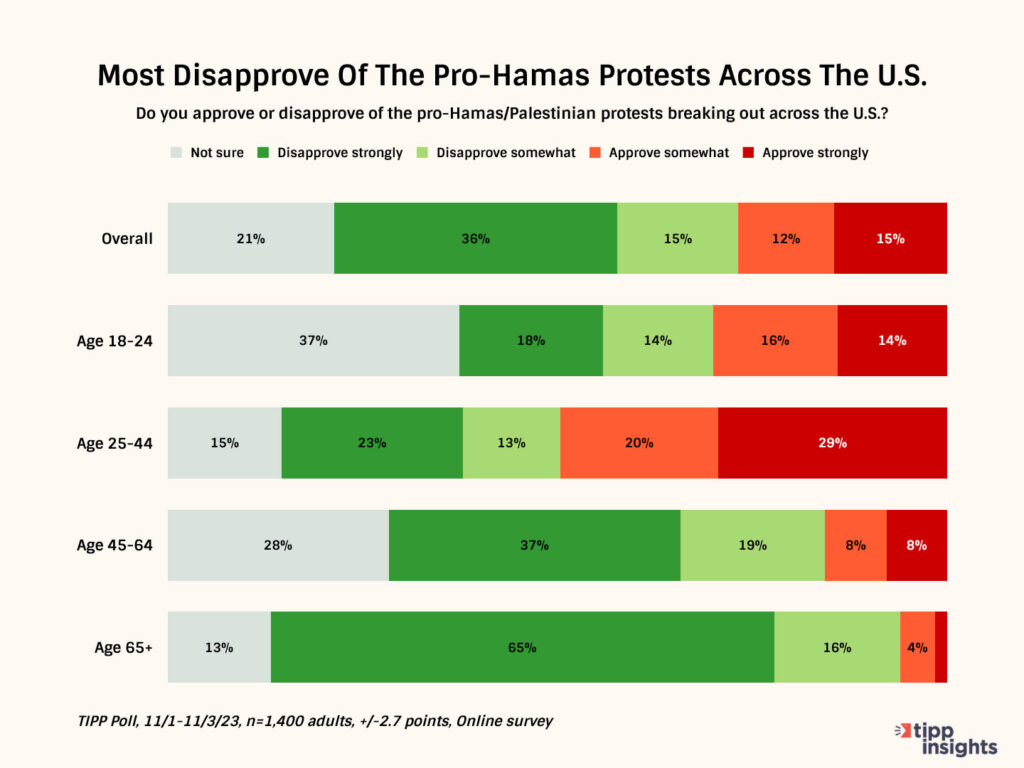
General responses to the two TIPP queries on Iran provided some of the most unified positions found in this polling.
In response to the question “To what degree do you agree or disagree with this statement: ‘The Islamic Republic of Iran is ultimately responsible for the Oct. 7th attacks on Israel?’”, a majority of respondents (56%) agree strongly or somewhat.
Just 11% disagree strongly or somewhat, while 33% were undecided, which was the single largest response to the poll.
Within those who did have an opinion, respondents who agreed strongly (30%, the second-largest response) outweighed those who agreed somewhat (26%), while among those disagreeing, the ones who disagreed somewhat (7%) outweighed those who disagreed strongly (4%, the lowest polling answer to this question).
Even among the 18-to-24-year-olds, 47% of whom were unsure, the numbers among those with an opinion went strongly against the Iranians, with 39% agreeing and only 14% disagreeing.
These strongly anti-Iranian responses suggest there may be scant support for any further attempts by the Biden administration to revive the Obama-era nuclear deal with Iran or to release any further resources to the regime in Tehran. And it’s worth noting that TIPP polling from last year, while reflecting strong support for the Iranian people, revealed similarly negative views on Tehran.
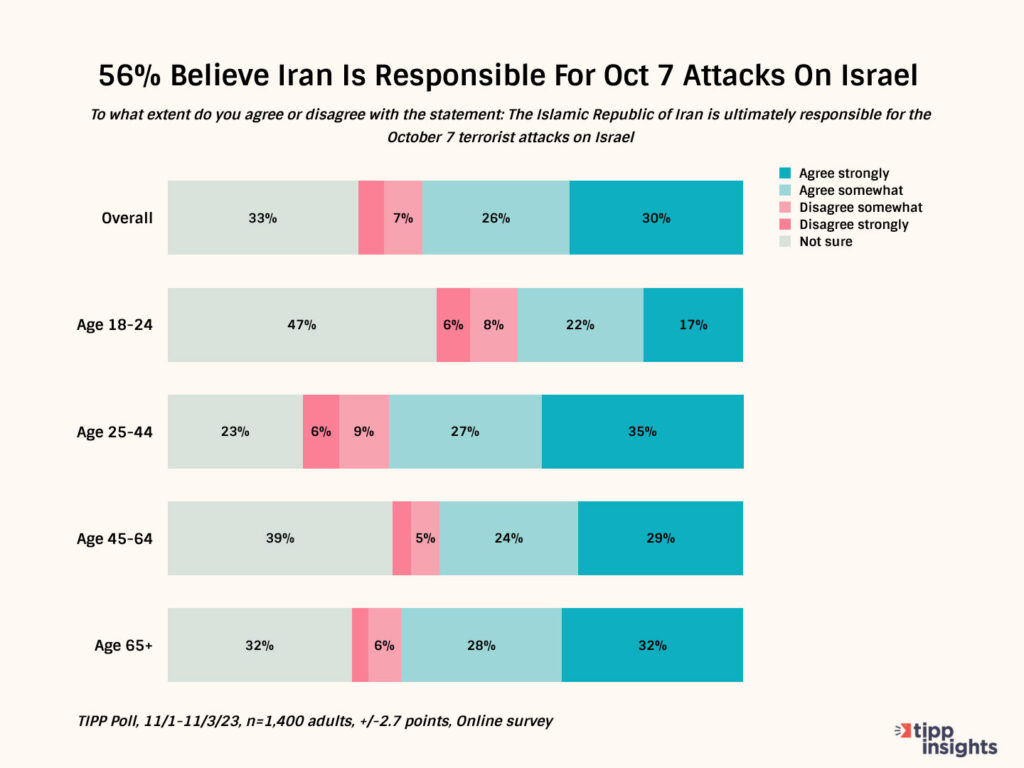
Finally, some of the clearest consensus in the poll can be found in the answer to “How concerned are you an Iranian-sponsored terrorist element will penetrate the U.S. through the southern border?”
Overall, 67% of respondents are very or somewhat concerned, while only 20% are not concerned—and only 12% are unsure (tied for the lowest number of “unsures” with the question on aid to Israel and Ukraine).
In fact, the concerned outweighed the unconcerned across both sexes and all ages, ethnicities, incomes and political affiliations, although there were some variations that are consistent with the breakdowns of other responses.
The 18-to-24-year-old age bracket had both the highest level of unconcern and the highest level of “don’t know” at 37% and 24%, respectively, while only 42% expressed concern, perhaps reflecting the same motivations revealed by the this age group in response to the other questions in this poll, but still putting them in the same general position as the vast majority of respondents to this poll.
Clearly, the possibility of a domestic terrorist threat supported by Iran and facilitated by the Biden administration’s inability or unwillingness to control the southern border has broadly seized the American people and may become a significant campaign issue in 2024.
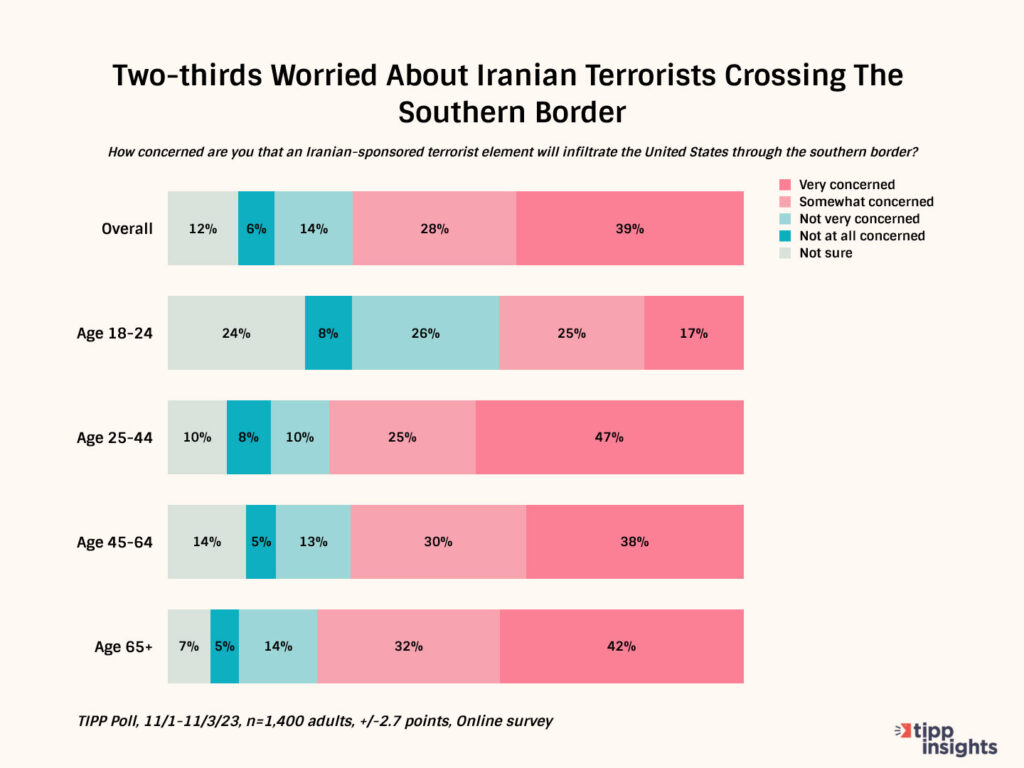
While American views on the Oct. 7 attacks will no doubt shift over time, this TIPP polling provides a useful snapshot one year out from the U.S. presidential election.
Broadly, the results reveal support for Israel and strong concerns about Iran, while responses on the Palestinians were more mixed.
But the single most noteworthy takeaway is the breakdown of responses by age. The 18-to-24-year-olds were one of the smallest groups of respondents to this poll at only 159 out of 1,400 overall, but their striking discrepancy from the rest of the group suggests that their experience with these issues on college campuses across the country is materially different from that of older citizens.
Have an opinion about this article? To sound off, please email letters@DailySignal.com, and we’ll consider publishing your edited remarks in our regular “We Hear You” feature. Remember to include the URL or headline of the article plus your name and town and/or state.
The post Polling on Israel, Hamas, Iran and Ukraine Finds Gen Z’s Views Diverge From Other Demographics appeared first on The Daily Signal.


0 Commentaires